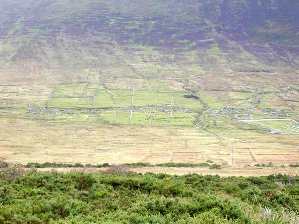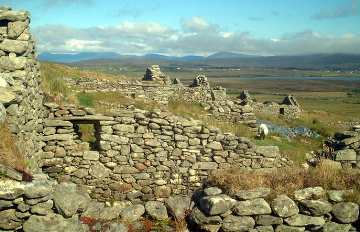
History of Achill

|
 |
|
 |
Covering an area of about 60sq miles, Achill is the largest of Ireland's islands. Achill has a long history of human settlement and there is evidence that Achill was inhabited as many as 5,000 years ago. Megalithic tombs and promontory forts testifying to this can be seen at Slievemore, along the Atlantic Drive and on Achill Beg Island.
 Kildamhnait on the south east coast of Achill is named after St. Damhnait,
or Dymphna, who founded a church there in the 16th century. There is also a holy
well just outside the graveyard. The present church was built in the 1700's and
the graveyard contains memorials to the victims of two of Achill's greatest
tragedies, the Kirchintilloch Fire(1937) and the Clew Bay Drowning (1894).
Kildamhnait on the south east coast of Achill is named after St. Damhnait,
or Dymphna, who founded a church there in the 16th century. There is also a holy
well just outside the graveyard. The present church was built in the 1700's and
the graveyard contains memorials to the victims of two of Achill's greatest
tragedies, the Kirchintilloch Fire(1937) and the Clew Bay Drowning (1894).
Kildamhnait Castle is a 15th century tower house associated with the O' Malley Clan, who were once a ruling family of Achill. Grace O' Malley, or Granuaile, the most famous of the O' Malley's was born in Clare Island around 1530. Her father was the chieftain of the barony of Murrisk. The O'Malleys were a powerful sea faring family, who traded widely and refused to submit to English rule. Grace became a fearless leader and gained fame as a sea captain and pirate. She is reputed to have met with Queen Elizabeth 1 in 1593. She died around 1603 and is buried in the O'Malley family tomb on Clare Island.
One of Achill's most famous historical sites is that of the Achill Mission or 'the Colony' at Dugort. In 1831 the Protestant Reverend Edward Nangle founded a proselytising mission at Dugort. The Mission included schools, cottages, an orphanage, a small hospital and a hotel (nowThe Slievemore Hotel). The 'Colony' was very successful for a time and regularly produced a newspaper called the 'Achill Missionary Herald'. The Reverend Nangle expanded his mission into Mweelin, where a 'school' was built. The Achill Mission began to decline slowly after Nangle was moved from Achill and was finally closed in the 1880's. Edward Nangle died in 1883.
In 1894, the Westport - Newport railway line was extended to Achill Sound. The train station is now a hostel. The train provided a great service to Achill, but it also fulfilled an ancient prophecy. Brian Rua O' Cearbhain had prophesied that 'carts on iron wheels' would carry bodies into Achill on their first and last journey. In 1894, the first train on the Achill railway carried the bodies of victims of the Clew Bay Drowning. This tragedy occurred when a boat overturned in Clew Bay, drowning thirty two young people. They had been going to meet the steamer which would take them to Scotland for potato picking.
The Kirkintilloch Burning Disaster in 1937 fulfilled the second part of the prophecy, when the bodies of ten victims were carried by rail to Achill. These people had died in a fire in a 'bothy'. This term referred to the temporary accommodation provided for those who went to Scotland to pick potatoes. Young people from Achill spent their summers work in Scotland. Nowadays, most of the young people of Achill continue in school until they are 17 or 18, in one of the two post-primary schools and gain employment in modern high tech companies in Ireland and abroad.
In 1852, Dr. John McHale, Archbishop of Tuam set aside land in Bunnacurry for the building of a monastery. A Franciscan Monastery was built which, for many years provided an education for local children. The ruins of this monastery are still to be seen in Bunnacurry today.

Close by Dugort, at the base of Slievemore mountain lies the Deserted Village. There are approximately 80 ruined houses in the village.
The houses were built of unmortared stone, which means that no cement or mortar was used to hold the stones together. Each house consisted of just one room and this room was used as kitchen, living room, bedroom and even stable.
If one looks at the fields around the Deserted Village and right up the mountain, one can see the tracks in the fields of 'lazy beds', which is the way crops like potatoes were grown. In Achill, as in many areas of Ireland, a system called 'Rundale' was used for farming. This meant that the land around a village was rented from a landlord. This land was then shared by all the villagers to graze their cattle and sheep. Each family would then have two or three small pieces of land scattered about the village, which they used to grow crops.
For many years people lived in the village and then in 1845 Famine struck in Achill as it did in the rest of Ireland. Most of the families moved to the nearby village of Dooagh, which is beside the sea, while some others emigrated. Living beside the sea meant that fish and shellfish could be used for food. The village was completely abandoned which is where the name 'Deserted Village' came from.
No one has lived in these houses since the time of the Famine, however the families that moved to Dooagh and their descendants, continued to use the village as a 'booley village'. This means that during the summer season, the younger members of the family, teenage boys and girls, would take the cattle to graze on the hillside and they would stay in the houses of the Deserted Village. This custom continued until the 1940's. Boolying was also carried out in other areas of Achill, including Annagh on Croaghaun mountain and in Curraun.
At Ailt, Kildownet, you can see the remains of a similar deserted village. This village was deserted in 1855 when the tenants were evicted by the local landlord so the land could be used for cattle grazing, the tenants were forced to rent holdings in Currane, Dooega and Slievemore. Others emigrated to America.